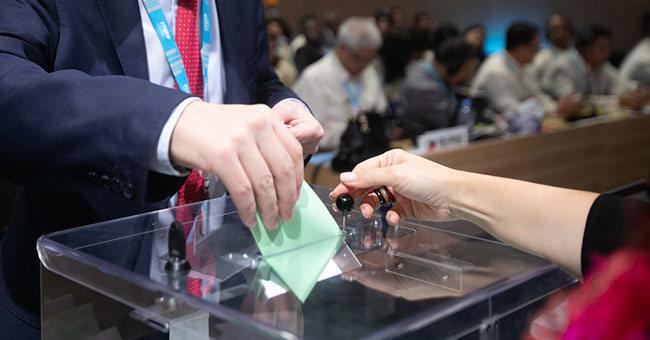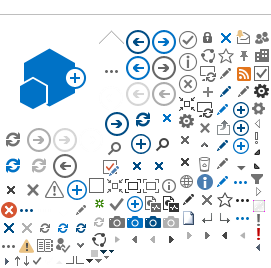
The International Telecommunication Union (ITU) works on behalf of its 194 Member States, through its highest governing body, the Plenipotentiary Conference (PP), held every four years.
The Plenipotentiary Conference elects the organization's Secretary-General, Deputy Secretary-General, and Bureau Directors for each sector: Radiocommunication, Telecommunication Standardization, and Telecommunication Development. It also elects the 12-member Radio Regulations Board (RRB) and the 48-state membership of the next ITU Council.
The next ITU Plenipotentiary Conference, or “PP-26", taking place in Doha, Qatar from 9 to 27 November 2026, will elect the ITU leadership team for the coming four years.
The election process
Elected positions
Unlike other United Nations agencies, which have just one elected head, ITU has five top posts filled by elected officials.
Under the rules laid out in the ITU Constitution, elected officials may serve a maximum of two four-year terms in any elected post. There is no restriction on those who have already served in an elected post from putting forward a candidature for a different elected post.
ITU's rules and procedures ensure fairness, impartiality, and transparency in its election campaigns. Candidacies for the five posts are open only until 23:59 CET (Geneva) on the 28th day prior to the conference, i.e., Monday, 12 October 2026.
The election process is set to begin on Thursday, 12 November, starting with the election of the next Secretary-General.
Candidacies
Current lists of candidates for ITU's elected management posts and RRB memberships, along with their CVs and vision statements, are available on the PP-26 website as candidacies are being received. The list of Member States running for the 48-seat Council is also available here and classified by region.
Voting rights
All elected positions at ITU are filled through voting among ITU's Member States at the Plenipotentiary Conference. Election outcomes are determined equitably through one vote for each ITU Member State.
In order to have the right to vote, Member States must be parties to the Constitution and Convention of ITU and must not be in arrears in their payments into the ITU budget.
Member States also need to have their credentials in order. These are documents that confer full powers to the representative of a Member State to vote at PP-26 and to sign the Final Acts of the conference. Each Member State's credentials must be signed by its Head of State, Head of Government, or Minister of Foreign Affairs.
Elected Officials
The voting process for elected officials
Elections for ITU's five most senior posts – i.e., those designated for elected officials – are conducted by secret ballot.
These elections are normally held in three stages: first, the election of the Secretary-General; followed by the election of the Deputy Secretary-General; and then the election of the Directors of the Bureaux for ITU's three Sectors. Elections for the three Director posts run concurrently.
To be elected, any candidate must secure a majority of votes. In accordance with the ITU General Rules of Conferences, Assemblies and meetings of the Union, the required majority consists of more than half the delegations present and eligible to vote. Invalid and blank ballots are not counted.
If no candidate obtains a majority in the first ballot, then one or, if required, two further ballots are held, with an interval of at least six hours between each announcement of results (unless otherwise decided by the conference).
If, after the third ballot, no candidate has obtained the necessary majority, then a fourth ballot follows between only two candidates. This fourth ballot occurs after an interval of at least twelve hours (unless otherwise decided by the conference) and involves the two candidates who secured the largest number of votes at the third ballot.
Date of taking of office
Newly elected or re-elected ITU officials begin their tenure on the dates determined by the Plenipotentiary Conference at the time of their election and remain in office until dates determined by the next Plenipotentiary Conference.
The next ITU management team is expected to take up its duties from 1 January 2027, unless otherwise decided by the conference. Under current rules, elected officials in the current management team may run for re-election only once in any given post.
ITU Council
Council composition and role
PP-26 will elect 48 of ITU's Member States, for seats allocated among five regions spanning the globe, for the next governing Council.
The Council serves as ITU's governing body during the four years between Plenipotentiary Conferences. It meets every year in Geneva, Switzerland, including in years when the Plenipotentiary Conference is also held.
The Council ensures constant oversight of ITU Secretariat activities, policies, and strategies; manages working groups on specific topics designated at the Plenipotentiary Conference or by the Council itself; and prepares the ITU Strategic and Financial Plans for presentation to the Plenipotentiary.
Each of ITU's five administrative regions is entitled to a specific number of Council seats, allocated as follows:
- Region A — The Americas: 9 seats.
- Region B — Western Europe: 8 seats.
- Region C — Eastern Europe and Northern Asia: 5 seats.
- Region D — Africa: 13 seats.
- Region E — Asia and Australasia: 13 seats.
Council membership as a whole equates to one-quarter of the overall number of ITU Member States. A Plenipotentiary decision in 2010 increased the number of Council seats from 46 to the current 48 to reflect additions to ITU's global membership (now 194 Member States).
There is no restriction on how many countries can put forward candidatures, and no restriction on the number of terms a country may serve on the ITU Council.
The voting process for ITU Council Membership
Voting for ITU Council membership normally occurs through a single round of voting. Those Member States declared as candidates and obtaining the highest number of votes for each regional allocation (i.e., the top 13 for Africa, the top 8 for Europe, and so on) will be elected for the coming four-year period, i.e., 2027-2030 inclusive.
In case of a tie for places within one region, the final result is resolved through a second round of voting (Special Ballot) involving only the candidate countries concerned. This occurs at an interval of at least six hours after the first round (unless otherwise decided by the conference).
If the vote remains tied after the second round of voting, the Plenipotentiary Conference Chair draws lots to determine the winning country or countries.
For more information: https://pp.itu.int/2026/en/elections/
The Radio Regulations Board (RRB)
The RRB's composition and role
The Radio Regulations Board (RRB) comprises 12 members from ITU's five administrative regions: A. The Americas; B. Western Europe; C: Eastern Europe and Northern Asia; D: Africa; and E: Asia and Australasia.
The RRB's duties comprise:
- Approving new or revised Rules of Procedure in cases where there are difficulties and inconsistencies in the application of the ITU Radio Regulations and regional agreements, and to convert the ITU Radiocommunication Bureau's practices in the application of the Radio Regulations and regional agreements into Rules of Procedure.
- Consideration of cases dealing with the review of findings by the Radiocommunication Bureau, following a request by an administration, which cannot be resolved by the use of the Rules of Procedure.
- Consideration of any appeal against a Bureau decision or any other request submitted by an administration.
- Consideration of reports on harmful interference and reports of alleged contravention or non-observance of the Radio Regulations.
- Consideration of any other matters which cannot be resolved by the Radiocommunication Bureau.
- Identification of matters which should be referred to ITU's radiocommunication conferences.
- The examination of any item relating to assistance in the application of the Radio Regulations at the request of any national administration, or of any item requested by any member of the Board or by the Director of the Radiocommunication Bureau.
The voting process for RRB membership
Elections for membership of the Radio Regulations Board normally occur through a single round of voting, with members elected to the Board based on a regional allocation of seats (like for the ITU Council): two seats each for regions A, B, and C, and three seats each for regions D and E.
The Radio Regulations Board is composed of up to 12 members, or up to the equivalent of 6% of the total number of Member States, whichever number is greater. Each Member State may propose only one candidate, and the number of seats per region is allocated based on the total number of ITU Member States from that region. Members of the Radio Regulations Board shall not be nationals of the same Member State as the Director of the Radiocommunication Bureau.
The candidates receiving the largest numbers of votes in each region, within the limit of the number of seats allocated per region, shall be elected as Board members. Elections at PP-26 will determine RRB members for 2027-2030.
If required, a special ballot will be held to decide between candidates from the same region who have received equal numbers of votes. If, following the special ballot, there is still a tie between several candidates for the same region, the eldest of the candidates still in contention shall be declared elected.
Last update: November 2025
